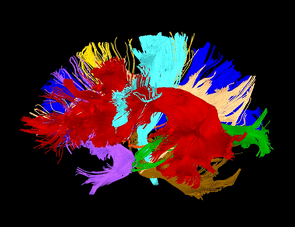The areas of the brain most relevant for the integration of information and consciousness
Through a new method based on computational modelling that identifies the dynamics of functional areas involved in processing information over time, in an article published in the journal NeuroImage, by Gustavo Deco et al., ICREA research professor and head of the Center for Brain and Cognition.
The human experience, aware of perceptions, memories and emotions, is based on the flexible integration and segregation of the information that reaches it through the senses. This integration of information is above, and beyond, the information available from the sum of the parts, and as such, it has been associated with consciousness.
Large-scale projects such as the Human Connectome Project (Van Essen et al., 2012) and the Human Brain Project (Gerstner et al., 2012) have begun to develop a structural and functional map of the human brain providing the experimental tools for a deeper understanding of how the brain integrates and segregates relevant information.
 The brain requires organizing information in consistent and distributed dynamic states
The brain requires organizing information in consistent and distributed dynamic states
In the brain, the integration of information is likely to take place in a functionally coherent network, but distributed into several regions, where the calculi are highly segregated. In the brain there are areas of dense interconnectivity that have been identified as essential structural axes for the integration and segregation of information that comes through nerve stimuli and that the brain must optimize in order to promote flexible cognition and the behaviour targeting a specific purpose. The brain requires organizing information into consistent dynamic states distributed through its interconnected neural networks. The question is whether these regions are sufficient to maintain the information flow optimally over time.
For cognitive flexibility various features of the organization of the brain have been proposed, but none of them has been assessed in the course of time. The main goal of a study published by Gustavo Deco, ICREA research professor and director of the Center for Brain and Cognition (CBC) at the Department of Information and Communication Technologies (DTIC) at UPF, published in the journal NeuroImage, was to study the relevance of the functional dynamics of each brain region with respect to the integration and segregation of information in the course of time.
To do so, the authors combined functional and structural data from neuroimaging with whole-brain computational modelling, in order to investigate the role of the regions of the brain in integrating functional connectivity. The study was conducted in conjunction with researchers from the Department of Psychiatry at the University of Oxford (UK) and researchers from the Department of Clinical Medicine at the University of Aarhus (Denmark).
Determination of the areas most involved in integration
The researchers have used whole-brain computational modelling of neural activity to determine the involvement of highly interconnected areas in the functional dynamics of the brain over time (dynamical workspace of binding nodes). These models have proved to be capable of reflecting and reproducing much of the dynamics and complexity of the real brain.
In this study, the authors have implemented a new way of measuring the integration of information in the brain over time with which they have identified the parts of the brain that are more involved in the integration and segregation of information.
One important aspect of the results of the study is that: “We have found that the elimination of the iteration of interconnected nodes of the workspace has a greater effect on the integration and coding of information than if we remove the highly interconnected nodes”, the authors expressed in their work.
This is because, while the brain areas of dense interconnectivity generate almost half of the binding nodes, the remaining nodes have a low level of participation, although they play a significant role in the work area essential for the integration of information over time, which “goes beyond the mere description of the essential structural axes for the integration of information”, affirms Gustavo Deco, first author of the study.
Related work:
Gustavo Deco, Tim J. Van Hartevelt, Henrique M. Fernandes, Angus Stevns, Morten L. Kringelbach (2017), "The most relevant human brain regiones for functional connectivity: Evidence for a Dynamical workspace of binding nodos from whole -brain computational modelling ", NeuroImage, 146, pp.. 197-210.
